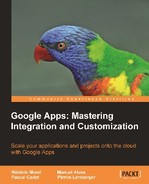Google Apps, as we saw in Part 2, are at the core of Google's offer for communication and collaborative tools. However, in most cases, these basic services will not be enough and the need for closer integration with the existing IS data will remain. An important part of the integration certainly involves using an existing business directory for Gmail contacts. But, more generally, the integration process can go two ways and there are recurring issues that need to be addressed. First, there is the need for Google Apps to access existing enterprise data. Second, there is the need for existing applications to access data managed by Google Apps. In the first case, you could consider using a document repository based on Google Docs, for instance, or using a resource calendar based on Google Calendar. In the second case, you could consider integrating some Google Apps like Gmail or Google Calendar within an existing enterprise portal. Even more important is the integration of Google Apps in an existing security realm or an SSO domain. For each of these questions, there are solutions, provided either directly by Google or by its partners. The five chapters of this part of the book review the various aspects of these two categories of solutions.
In Chapter 7, Managing a Google Apps Domain, we start by reviewing the basics of the administration tasks for a Google Apps domain. A mastery of these tasks is a prerequisite to any form of advanced integration endeavor. Managing user accounts, creating groups, and granting appropriate rights are the main topics here. After reviewing the main concepts related to identity management and to authentication delegation, Chapter 8, Federated Identity and SSO presents the main tools that allow the integration of the Google Apps in an SSO domain. Chapter 9, Advanced Integration presents data integration with the Google Apps in two directions. The first deals with third-party applications, which need access to data managed by the Google Apps. Access here is through a set of specialized APIs. Conversely, the Secure Data Connector allows Google Apps users to access enterprise data even when these are behind a firewall. Google desktop technologies are discussed in Chapter 10, Google "Workstation". The specifics of the Google Chrome browser are presented, as well as the two operating systems proposed by Google: Android, which is already available on dozens of smartphones and Chrome OS, which is an innovative operating system, both light and fast and meets the needs specific to working online. Finally, Chapter 11, Third-party Extensions reviews four products that are representative of the integration solutions from Google's partners. There are office tools and workflow tools. They are all available on the Google Apps Marketplace.
